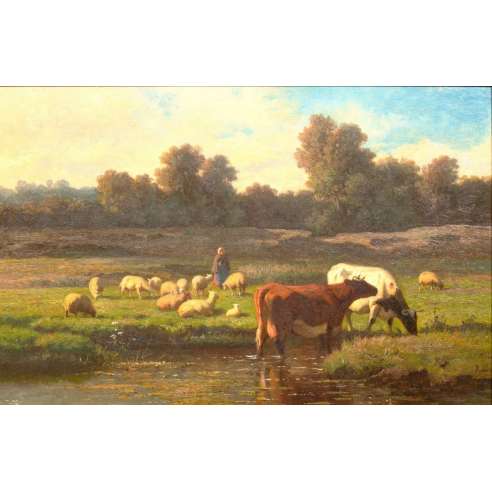"Animaux au Pâturage" by Louis Robbe is a quintessential example of 19th-century Belgian animal painting, showcasing Robbe’s skill in depicting rural life with realism and sensitivity. The painting reflects the influence of Eugène Verboeckhoven, particularly in its detailed rendering of animals and its focus on the pastoral landscape.
The painting depicts a serene pastoral scene, typical of Louis Robbe’s work, featuring a mix of cows and sheep grazing peacefully in a lush meadow. A shepherd is seen in the midground, overseeing the animals. The foreground is dominated by a calm body of water reflecting the grazing cows. The reflections add depth to the scene, drawing the viewer's eye into the landscape. The midground features the grazing animals spread across the meadow. The placement of the animals is balanced, with the cows and sheep interspersed naturally across the landscape. The background is filled with a dense line of trees, which provides a natural barrier and frames the scene. The sky above is softly lit, with warm tones suggesting either early morning or late afternoon.
Robbe employs a naturalistic palette dominated by greens, browns, and yellows. The greens of the grass and trees are vibrant, reflecting the healthy, fertile environment. The warm tones of the sky and the soft light illuminating the animals create a peaceful, idyllic atmosphere. The play of light and shadow is expertly handled. The light appears to come from the right, casting gentle shadows and highlighting the texture of the animals’ fur and the grass. The careful use of light adds realism and a three-dimensional quality to the scene.
Robbe’s brushwork is precise and detailed, particularly in the rendering of the animals and the textures of their fur. The water in the foreground is depicted with fluid, smooth strokes that capture the reflections and the subtle movement of the water. Robbe’s painting exemplifies realism, with a meticulous attention to detail. The animals are depicted with anatomical accuracy, and the landscape is rendered with a keen observation of nature. This commitment to realism aligns Robbe with the broader realist movement of the 19th century.
Eugène Verboeckhoven, a leading Belgian animal painter, was one of Robbe’s early mentors. Verboeckhovens’ influence is evident in "Animaux au Pâturage" and reflects a shared interest in the rural landscape and the depiction of livestock. However, while Verboeckhoven’s work often has a more polished, almost idealized quality, Robbe’s approach is slightly more naturalistic, capturing the everyday reality of rural life with a softer, more atmospheric touch.
On the back of the painting there is an old label written by the painter himself which reads :
‘Je déclare que le tableau ci-joint représentant des animaux au pâturage a été peint par moi et je le déclare parfaitement original. Bruxelles, Le 30 aout 1861 L. Robbe. ‘
(I hereby declare that the attached picture of cattle grazing in a meadow was painted by me, and I declare it to be completely original. Brussels, 30th August 1861 L. Robbe.)
























